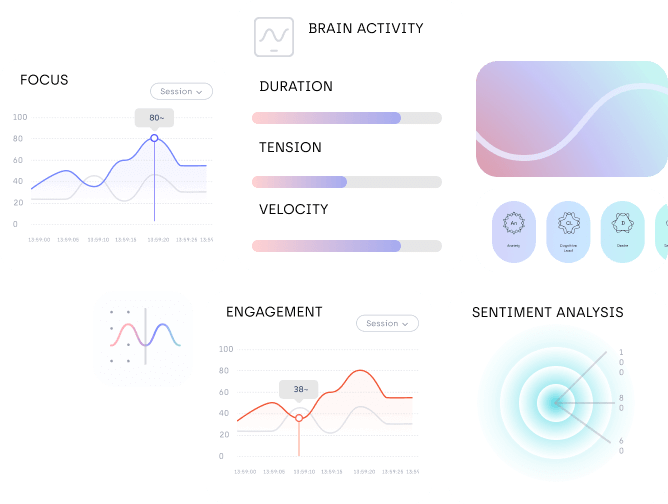
Delivering the Human element
in AI-based technology
Creating the first universal standard
Today’s brain technologies, such as fMRI or EEG, lack temporal resolution and require manual placement of the electrodes, expertise in operation, and significant physical space. In addition, the anatomical differences between people distort the Signal to Noise Ratio (SNR) making it impossible to rely on the Brain data that has been collected. Simply put, Data from individuals collected not with a universal standard will often be imprecise, making it impossible for researchers to compare between studies, benchmark, and accumulate Brain Data for meaningful and accurate conclusions.
Auto Donning
With the Brain Sensei™ Headgear, brain.space has developed the first ever Closed Loop Based Auto Donning - an automatic sensors calibration system.
This groundbreaking Auto Donning technology automates the process by calibrating the sensors to each user’s head, without needing assistance from a technician. Auto Tuning Sensors, located inside the Brain Sensei™ headgear, take only 5 minutes as compared with 30 minutes for the Wet EEG.
Why is comfort important?
Less comfortable technologies may claim to produce high quality signals, but if the user is in pain or uncomfortable, the signal being received (while possibly accurate) will be overwhelmed by the user’s discomfort from the treatment itself, influencing the results. With comfort in mind, our Auto Donning system calibrates to the user’s head, maintaining a continuously accurate and high quality EEG signal over time.
Brain GPS™
Brain GPS™ Maps the brain and precisely correlates the sensors with the correct functional areas, delivering a complete reconstruction of the functional brain areas within the experiment flow.
After the Brain Sensei™ is on the user’s head and the Auto Donning technology calibrates to their scalp, the next step in the process is our Brain GPS™ technology. By using AI and ML models, the Brain GPS™ is allowing the standardization of the data collected from the brain, and collection of big Brain Data, making our artificial intelligence models become better at predicting and understanding human behavior.
Human beings have unique head sizes, head shapes, skulls, scalps and hair styles. Additionally, the brain’s actual shape and functional areas are not uniform. Like veins, we all have them but their placement can differ between individuals. This variability makes it very difficult to measure and record Brain Data with manual EEG systems.
Brain Cloud
All of the standardized data collected from the Brain Sensei™ is now tagged and transmitted to our Brain Cloud. Algorithmic engines that clean the data, remove artifacts and prove the clearest Signal to Noise Ratio. The Brain Cloud will be comprised of massive data sets from diverse use-cases, empowering the generation of actionable intelligence, what we call Brain Insights, such as Focus, Fatigue, Excitement and many others, which our customers can view in real-time via accessible dashboards. Organizations collecting Brain Data with their own equipment can format to our standards and use the Brain Cloud via API, in order to benefit from the collective networking effects of shared big data.

Brain Insights
of human behavior
Brain Insights are indexes of subjective measurements of a person's mental state, based on high resolution brain waves, presented on a scale.
-
Anxiety
-
Cognitive Load
-
Desire
-
Determination
-
Engagement
-
Euphoria
-
Focus
-
Mental Fatigue
-
Reaction Time
-
Resilience